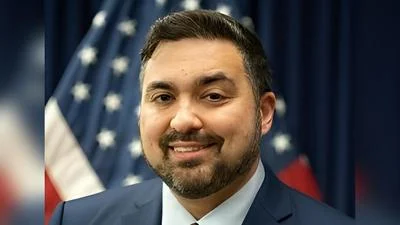The Congressional Record is a unique source of public documentation. It started in 1873, documenting nearly all the major and minor policies being discussed and debated.
“STATEMENTS ON INTRODUCED BILLS AND JOINT RESOLUTIONS” mentioning the Department of Interior was published in the Senate section on pages S6535-S6537 on Sept. 9, 2015.
The publication is reproduced in full below:
STATEMENTS ON INTRODUCED BILLS AND JOINT RESOLUTIONS
By Mrs. FEINSTEIN (for herself and Mrs. Boxer):
S. 2013. A bill to authorize the Secretary of Veterans Affairs to enter into certain leases at the Department of Veterans Affairs West Los Angeles Campus in Los Angeles, California, and for other purposes; to the Committee on Veterans' Affairs.
Mrs. FEINSTEIN. Mr. President, I rise today to introduce legislation to facilitate additional housing and services for Southern California's veterans. It would allow the Department of Veterans Affairs to leverage the resources of local governments and non-profits to build supportive housing for veterans at the West Los Angeles VA Medical Center Campus. My colleague Senator Barbara Boxer is a cosponsor of this bill. Congressman Ted Lieu is introducing companion legislation in the House of Representatives.
The Department of Veterans Affairs, Mayor of Los Angeles and Los Angeles County Board of Supervisors all support this legislation.
Los Angeles has the largest concentration of homeless veterans in the United States, currently estimated to be 4,300. These are brave men and women who served our nation with honor, and I believe it is our duty to ensure they have access to housing and the clinical services of the Greater Los Angeles VA Health System.
This legislation would provide two authorities to the department. First, it would allow the West Los Angeles VA to use enhanced-use leases to engage in public-private partnerships to provide supportive housing for veterans. Enhanced-use leases allow the department to leverage private or local funding and partners to construct new housing on the campus. For example, California passed a bond measure in 2014 that provides $600 million in funding for the construction of supportive veteran housing. I want to note that this enhanced-use leasing authority is the same authority that the department has for every other VA campus in the nation.
Second, my bill would allow the West Los Angeles campus to enter into out-leases to provide critical services to veterans housed on the campus, ranging from education to recreation. Services must be provided to create a healthy and sustainable community for veterans. Veterans housed on the campus will need access to mental health care options, job training, and physical recreation. These services can be provided by community partners leasing property on the campus, such as the University of California--Los Angeles.
I would like to make you aware of the long history of the West Los Angeles VA campus. This campus is approximately 400 acres and is located at the intersection of Wilshire Boulevard and Interstate 405. The land was deeded to the Federal government by former Senator John P. Jones, for use exclusively as a ``soldier's home.'' The beautiful campus has numerous historic buildings, including a church.
In 2007, I included language in an appropriations bill to prohibit the ability of the Department of Veterans Affairs to lease or sale any property on the West Los Angeles Campus, due to reports of mismanagement and inappropriate leasing of VA property to commercial entities. In several cases, these commercial entities had nothing to do with serving veterans.
After the ban was signed into law, questionable practices continued through land-sharing agreements. This led to the American Civil Liberties Union, ACLU, of Southern California filing a lawsuit against the department in 2011 over its mismanagement of the campus.
In a large part due to our new Secretary of Veterans Affairs, Robert A. McDonald, the department reached a settlement with the ACLU earlier this year to return the campus to its original purpose to serve veterans. The ACLU and the department are working to create a new Master Plan for the campus that includes community input, which I expect will include a focus on ending veteran homelessness in Los Angeles. My legislation will provide the department with the tools it needs to get veterans off the streets and ensure the West Los Angeles campus truly serves the veterans of Los Angeles.
This legislation contains important oversight provisions to ensure the management mistakes of the past are not repeated.
First, it maintains a restriction put in place in 2007 that prohibits any part of the West Los Angeles campus from being sold, transferred, or otherwise disposed of.
Second, it requires the VA to report to Congress 45 days before entering into any lease, and to provide an annual evaluation of all land-use and leases on the campus.
Third, it requires regular audits by the Office of the Inspector General, OIG, and restricts the VA from entering into any new leases if the OIG finds any violation of Federal law or policy, or gross mismanagement of the campus. The VA would have to certify to Congress that it addressed any issues found by the OIG before entering into new leases on the campus.
Finally, the legislation requires all land-use, including leases, to be consistent with the new Master Plan that is agreed upon for the campus. It also requires all leases to principally benefit veterans.
I believe these oversight provisions will ensure that the historic mismanagement of the West Los Angeles campus will not recur.
Let me conclude by saying that Congress must meet its responsibility to care for the veterans who have fought for our Nation's freedom and security. It would be a shame to leave private resources untapped in a city where 4,300 veterans are currently homeless. I hope all of my colleagues will support enacting this legislation as quickly as possible.
______
By Ms. MURKOWSKI:
S. 2017. A bill to amend the Alaska Native Claims Settlement Act to recognize Alexander Creek, Alaska, as a Native village, and for other purposes; to the Committee on Energy and Natural Resources.
Ms. MURKOWSKI. Mr. President, today I introduce legislation, already pending in the House of Representatives, where it was first introduced in 2009, 2011, and 2013 by Alaska Congressman Don Young to finally settle a long-standing injustice to the Native residents of Alexander Creek, a Native village built along the creek that runs into the Susitna River near its entrance to Cook Inlet, north of Anchorage and southwest of Wasilla, AK.
The story of Alexander Creek's Alaska Natives is a sad story, in that it is a story of Natives whose village happened to be located at the site of one of the State's prime salmon fishing locations, a site that may have prompted efforts by some to deliberately prevent the village from rightfully gaining the lands it was entitled to receive under the Alaska Native Claims Settlement Act, ANCSA, passed by this Congress in 1971.
It is especially sad since the villagers succeeded in the Federal courts in winning confirmation of their status as a village under ANCSA nearly four decades ago but because of decades of mistakes and misunderstandings, still have received only about 10 percent of the land village residents are entitled to receive.
The legislation I am introducing today would give the Secretary of the Interior the authority to enter into negotiations to settle aboriginal land claims with Alexander Creek, after conferring village instead of group status on the community. It gives the Secretary wide latitude to find a just, environmentally acceptable, and economically reasonable means to bring Alexander Creek to ``approximate parity'' to the other more than 210 villages that were established by the 1971 law that settled all aboriginal lands claims in Alaska.
Alexander Creek, whose Native name is Tuqentnu, traditionally was a healthy Native village with abundant resources, whose residents lived off fish traps located near the mouth of the Susitna River year round. While its population suffered as a result of whooping cough, measles, and influenza epidemics in the early 1900s caused by the influx of the non-Native population into upper Cook Inlet--the village being literally decimated by the 1918 epidemic--by 1939 the village had been reoccupied by Native families. When the Alaska Native Claims Settlement Act passed in December 1971, there were 37 residents of the village, 12 more than the 25 needed to be entitled to form a village corporation under the act and to be entitled to receive 69,120 acres around the core townships of the village.
The Bureau of Indian Affairs in 1971 made that determination. But the village had the misfortunate of being located in a prime salmon fishing area that was sought by the State of Alaska at the time of statehood in 1959 and that was later conveyed by the State to the then new Matanuska-Susitna Borough at the time of its creation in the early 1960s. Thus there was opposition to Alexander Creek being allowed to claim its lands. The State, in fact, protested its eligibility for land under ANCSA. A hearing was held before an administrative law judge on July 11, 1974, but oddly the hearing was not widely noticed and a number of village residents were specifically not told of the hearing, so they were not in attendance. When the appeals board released its decision on November 1, 1974, the board ruled that the village only contained 22 residents--3 short of the required number for creation--
simply because 5 other families and their children had not appeared at or testified at the hearing.
The board's decision was appealed to U.S. district court that reversed the appeals board's decision on November 14, 1975, ordering the reinstatement of Alexander Creek's ANCSA eligibility. While that decision was appealed by the State of Alaska, the lower court decision was upheld by the DC Circuit Court of Appeals on August 29, 1976, which ordered that the case be remanded back to the Secretary of the Interior for further proceedings. But since all of the land around Alexander Creek had already been conveyed to the State and to the Mat-Su Borough, the village was required to join other Cook Inlet region villages in selecting ``deficiency lands'' near Lake Clark to the southwest of the region. But the creation of the Lake Clark National Monument in 1978, prior to passage of the Alaska National Interest Lands Conservation Act in 1980, further complicated the land selection issue for the village.
Alexander Creek villagers, who could not afford independent legal counsel following the 1976 district court and court of appeals rulings, did not immediately pursue their claims to full village status and apparently did not understand the complexities of the Lake Clark land conveyance decisions. Somehow, they instead were convinced to sign an agreement with Cook Inlet Region, Inc., the regional corporation for the area, and the Interior Department in December 1979, where the village dropped its claim to be a village in exchange for receiving
``group'' status under the ANCSA, and also in return for being guaranteed 7,680 acres of land, some of which was to come from the State of Alaska and or the borough. While the State did provide the village with 1,686 acres, no borough or Federal land was conveyed to complete the 7,680-acre ``group'' agreement reached in 1979 until just recently.
It wasn't until the next generation of Native leaders arrived in the village that they realized that Alexander Creek never received the lands it should have received.
Over the past decade residents of the village have been seeking to have the original court of appeals decision affirmed and implemented. Over the years they have been gaining support for their efforts. First, BIA Alaska Region Field Representative Charles F. Bunch concluded after
``a thorough assessment'' that the BIA's original determination was correct and that Alexander Creek ``met the requirement'' for village eligibility and that the land conveyances should have been implemented. Recently the Alexander Creek village leaders have received support from the Alaska Federation of Natives, Cook Inlet Region, Inc., CIRI, the State of Alaska and the Matanuska-Susitna Borough, all agreeing that the village should receive its full lands promised under ANCSA--plus from a host of other groups.
So this legislation will reinstate Alexander Creek's eligibility, overriding the 1979 ``group'' agreement, reached under section 1432(d) of ANCSA, and giving the village the right to negotiate a fair settlement with the Interior Department. Under the act the Secretary is free, at his sole discretion, to propose what assets are to be provided Alexander Creek to capitalize the corporation, not setting any predetermined amount of land, cash, surplus Federal property or other assistance. The bill does hold the regional corporation for the area, Cook Inlet Region, Inc. harmless from any impacts of the village corporation's creation.
The Alexander Creek case represents a sad chapter in the story of the settlement of Native aboriginal land claims in Alaska. It is a story of Native land owners being actively discouraged from selecting their traditional lands, of being deliberatively misinformed about land selection processes so they would not qualify for their lands, of being pressured to accept inferior compromises so they would gain less land, and of then being ignored for far too long when it came time to consummate the inferior deal they were encouraged to accept. It clearly is time this Congress rewrites that chapter and allows it to have a happier ending.
______
By Ms. MURKOWSKI:
S. 2018. A bill to convey, without consideration, the reversionary interests of the United States in and to certain non-Federal land in Glennallen, Alaska; to the Committee on Energy and Natural Resources.
Ms. MURKOWSKI. Mr. President, today I introduce legislation to aid an Alaska higher educational institution obtain title to property it no longer needs, and that the Federal Government clearly no longer wants. I rise to introduce legislation to clear the title to a 210-acre parcel in Glennallen, AK, so that the land can be put to more productive uses in the future.
Back in 1926 the Central Alaska Mission began operations in Glennallen. In 1954 it received a Federal land grant from Congress, modified in 1959, and received 210 acres in ``downtown'' Glennallen--
the current site of the hospital and radio station and former site of the Alaska Bible College. In 1961 it actually opened the Bible College on 80 acres of the tract, the site apparently having about 64 separate buildings erected on it. The 1959 land grant, like many in first the Territory of Alaska and later the State of Alaska, had a clause that should the property no longer be used for religious/public purposes that it would revert to the federal government. The Bible College, because of a lack of students in Glennallen, moved into the Matanuska-
Susitna Borough, to Palmer, AK, last decade. Now it wishes to be able to sell the property to be rid of the maintenance costs on the facilities.
The problem is that there apparently are no non-profits or few businesses in Glennallen that can afford to pay the officially appraised value for the properties. The parent of the Bible College 3 years ago asked the Federal Bureau of Land Management, BLM, administratively to start a process where it would decide the value of the properties and what it would have to pay the government to buy out the value of the ``reversionary clause'' so it could obtain clear title to sell the properties for whatever amount it could get. That appraisal was conducted mutually and came back late last year that the 210-acres, minus a sewage lagoon on the property that has no sales value, is worth
$210,000. The college says the college can't afford that amount to buy out the value of the reversionary clause--because regardless of the appraisal, there is no entity in Glennallen that can afford to pay anywhere near that amount for the properties given the level of economic activity at present in the upper Copper River Valley in Alaska.
The college is arguing, correctly, that the Federal Government is wrong in setting the value of the reversionary clause as the full appraised value of the property for tax purposes. If willing sellers can't be found who can afford to pay the ``appraised'' value of the property, then obviously the appraisal process is faulty. Secondly, the college is arguing that it has fully met the goal of Congress in 1959 that the land be used for the public purpose of operating an educational institution. For more than 40 years the property was used by Alaska Bible College, the college only moving into a more urban part of Alaska when student levels proved insufficient to support the school. Clearly it makes no sense for the reversionary clause to remain in effect in perpetuity when land use patterns have changed. Third, the Federal Government does not need the land for any federal purpose. The land, not located in an urban setting in the small town of Glennallen, population, 491, is not suited for a park. The land is not needed for any Federal facility given its location in sparsely populated east central Alaska. Being inside the Glennallen city limits, the land can not be allowed to revert to a natural vegetative state under the town's ordinances. It simply makes good sense for the land to be sold for economic purposes so it can generate more revenues for the town's tax rolls. Given the real estate market in Glennallen, the Federal Government will lose far more money than it will make if it has to tear down the unwanted buildings in order to sell the property, or maintain them until another purpose for the structures can be found, at the current appraised tax values of the properties.
In each case, reversion of the lands to the Federal Government would result in Federal ownership of tracts unneeded for Federal purposes, but lands that would produce greater conveyance and management costs to the Federal treasury than are likely to be recovered through fair market sales. There is just no public policy purpose in the 21st century not to permit these very limited Federal reversion extinguishments, especially since the land did meet the purpose of the reversionary clause for more than four decades.
Passage of this act would cost the Federal Government nothing, but would aid the citizens of Glennallen by allowing the lands to be put to a better use, hopefully adding to the city's economy and perhaps increasing its future tax revenues. I hope this bill will be able to advance and become law within the 114th Congress.
____________________








